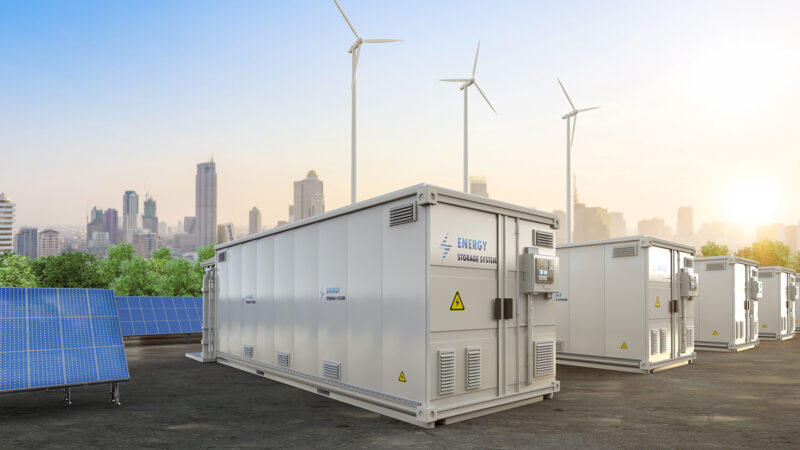Solar and wind power bring renewable energy to the grid, with the most significant limitation being the supply-demand imbalance, whereby demand is not high at midday when there is plenty of solar energy, but when electricity consumption spikes in the morning or at night, no power can be generated to maximize the use of the new energy sources. Energy storage systems (ESS) for utility-scale, residential, as well as commercial and industrial scenarios should be used to capture energy from renewable sources such as solar and wind during the day and deliver that power when demand or grid electricity prices are high. By storing energy for use during peak hours, ESS stabilizes the grid and reduces energy costs. For this reason, battery energy storage systems (BESS) are becoming very popular today, but they also present several design challenges, including safe use; accurate monitoring of battery voltage, temperature, and current; and balancing between the cells and the battery pack.
Challenge 1: Safety
The first challenge is to keep the battery safe throughout the lifetime of the BESS, which is typically more than 10 years.BESS applications typically use lithium-ion (Li-ion) batteries, particularly lithium iron phosphate (LiFePO 4 ) batteries.
Li-ion batteries are susceptible to smoke, fire, or explosion if voltage, temperature, and current exceed their maximum limits, so battery voltage, temperature, and current data must be monitored and protected. Therefore, the possibility of battery failure and battery management system failure should be considered and analyzed.
The BESS architecture is illustrated in Figure 1. The TI Stackable Battery Management Unit for Energy Storage Systems reference design describes a stackable battery management unit (BMU) that uses the BQ79616 to detect redundant data measurements. The Battery Control Unit Reference Design for Energy Storage Systems demonstrates a Battery Control Unit (BCU) with switches to ensure system safety.

Figure 1 BESS architecture
Challenge 2: Accurate Battery Monitoring
Accurate battery data ensures safety and maximizes energy storage capacity. Considering the wide, flat region of the LiFePO 4 charge and discharge curves, small cell voltage measurement errors can lead to large residual capacity errors, so accurate cell voltage and pack current measurements are important for accurate state-of-charge estimates. Accurate state-of-charge information is key to avoiding incorrect battery balancing, where overcharging and over-discharging can destroy the health of the battery. Another important measurement is temperature. Most battery fires and explosions are caused by thermal runaway of the battery.
Figure 2 shows TI’s stackable battery management unit reference design, which uses the BQ79616 battery monitor to achieve a ±3mV battery voltage error over the -20°C to 65°C range. For residential systems, designers can choose to use the BQ76952 battery monitor, which achieves a battery voltage error of ±5mV over the -20°C to 65°C range. Multiplexer switches extend the temperature measurement channels to ensure that the temperature of each battery cell and power bus connector is monitored. The stackable battery reference design retains additional temperature channels for diagnostic checking of the multiplexer switch.

Figure 2 TI’s stackable battery
Accurate and reliable current measurement solutions are also necessary for ESS charging status monitoring. The BQ79731-Q1 voltage and current sensors integrate dual 24-bit current-induced analog-to-digital converters and have redundant channels to help ensure system safety and the accuracy of current data.
Challenge 3: The Ability to Balance Cells and Battery Packs
Battery packs may draw current at different rates due to load variations. These variations can lead to imbalances in the remaining energy of the battery pack and reduce the maximum available energy of the entire ESS. Inconsistencies between cells and different thermal cooling conditions can also lead to imbalances between different cells, even within a single battery pack. Passive cell balancing uses resistance to dissipate cell energy and is not recommended for pack-level balancing as it generates excessive power consumption and heats the pack.
Battery pack imbalance worsens throughout the life of the product, considering that the life of an ESS may exceed 10 years. Some battery packs may age more than 10 years faster than others, forcing the user to replace the aging battery pack. Without robust pack balancing circuitry, the new pack must be charged or discharged to nearly equal the energy of the remaining packs in the ESS. But even this is risky because it is difficult, expensive, and labor intensive.
Battery cell imbalance is also affected by battery capacity. Battery manufacturers are developing larger capacity cells – from 280 Ah to 314 Ah and even 560 Ah – to optimize the energy cost per kWh of the overall ESS. Larger-capacity battery packs require a greater effective balancing current so that all cells in the pack continue to provide the same amount of energy.
There are several ways to balance energy. Figure 3 shows one method of charging and discharging a battery pack through a bi-directional isolated DC/DC converter via a high-voltage bus. By controlling the charging and discharging currents, the isolated DC/DC converter can balance the battery pack to match the remaining capacity or pack voltage. Since both the charging and discharging currents flow through the bi-directional DC/DC converter, the overall efficiency of the bi-directional DC/DC converter is low and the power rating is high.

Figure 3 A bidirectional isolation DC / DC converter from the battery pack to the high-voltage bus
Conclusion
Safe and reliable battery management systems remove concerns about the safety of lithium-ion and LiFePO 4 batteries and help extend the ESS life with carefully designed protection measures, even in cases of a single device failure. Accurate data sensing and battery pack and cell level balance, to achieve equal capacity charge and discharge, maximize the utilization rate of solar energy and other renewable energy, and ultimately enable the end users to obtain safe, stable, and low-cost renewable energy.













I am genuinely grateful to the owner of this website who has shared this fantastic post
at at this time.